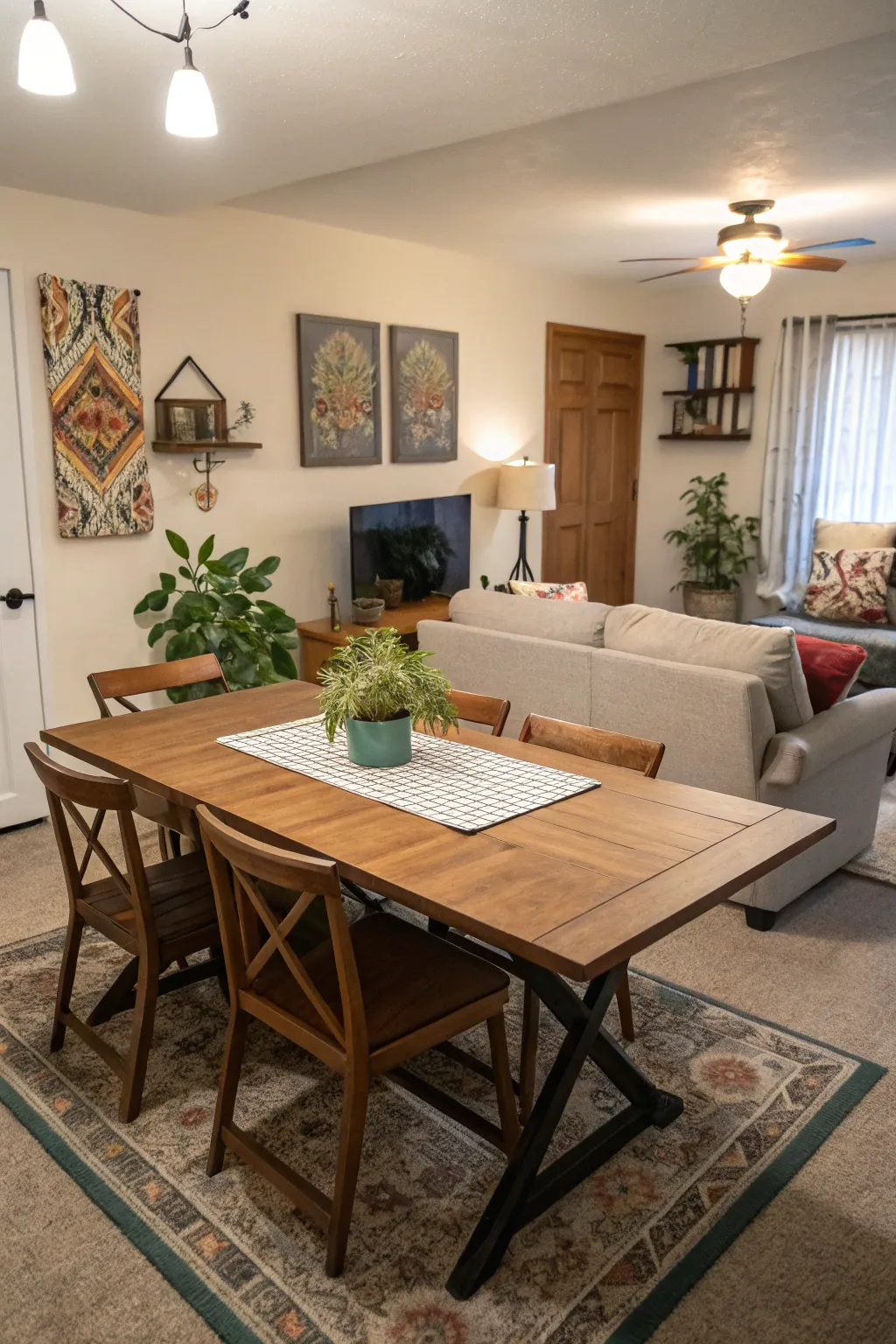Small spaces, big possibilities!
Have you ever wondered how your living room and dining area could feel not just functional, but truly delightful? With a splash of creativity and a few clever layout choices, you can turn even the coziest combo room into a welcoming, purposeful retreat.
Your dream home isn’t measured in square footage—it’s made in the moments you create right where you are.
1. Why Choose Glass or Acrylic?
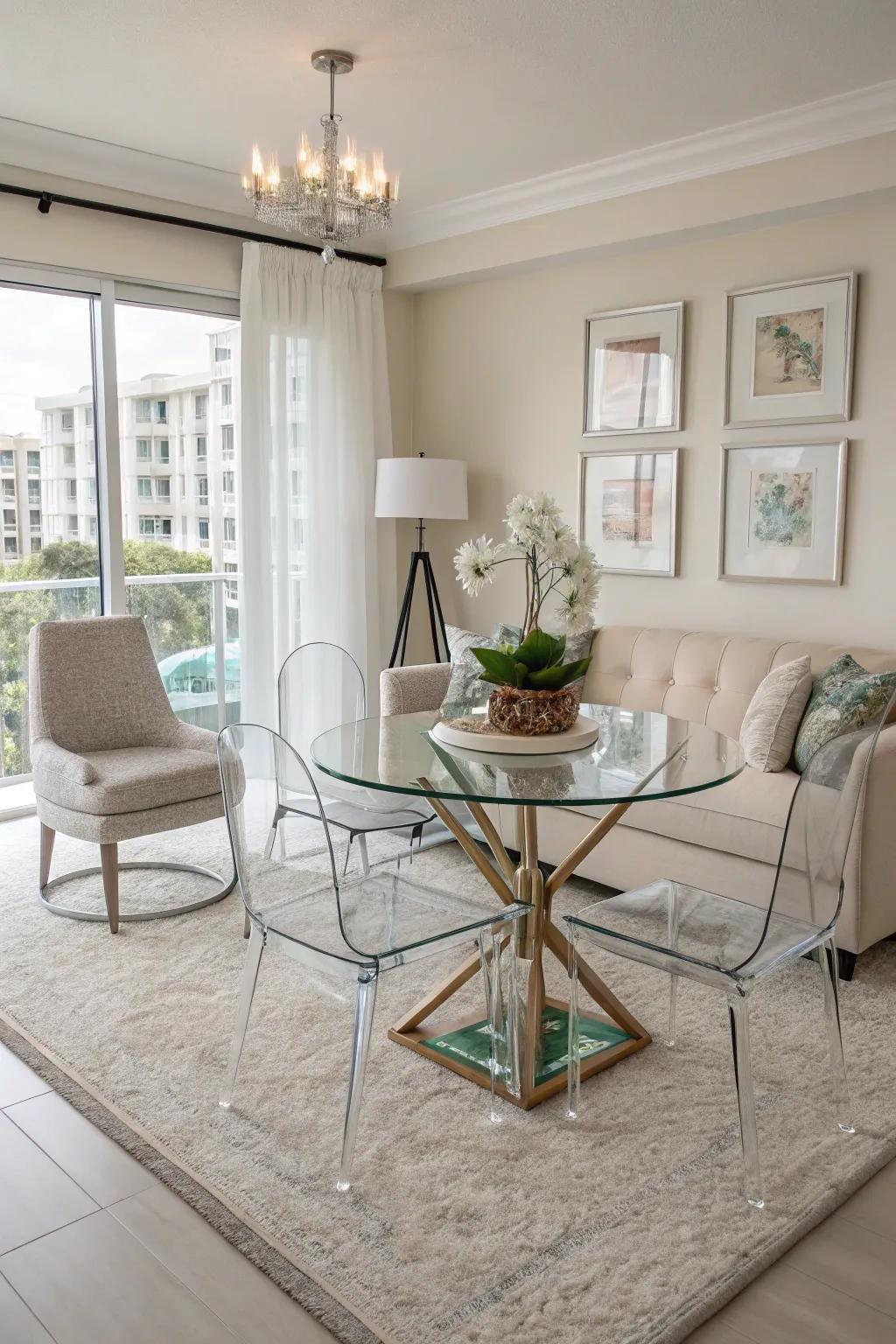
Light can be your best friend in a small living and dining room combo, and glass or acrylic pieces help it travel freely throughout your space. These materials don’t visually weigh things down—they almost disappear, letting color, pattern, and personality shine while your room stays airy.
Sometimes less is truly more. Swapping just one bulky table for a clear, acrylic option can make a world of difference. Go ahead, let your style breathe!
Check if these fit your needs:
2. Furniture That Does Double (Or Triple) Duty!
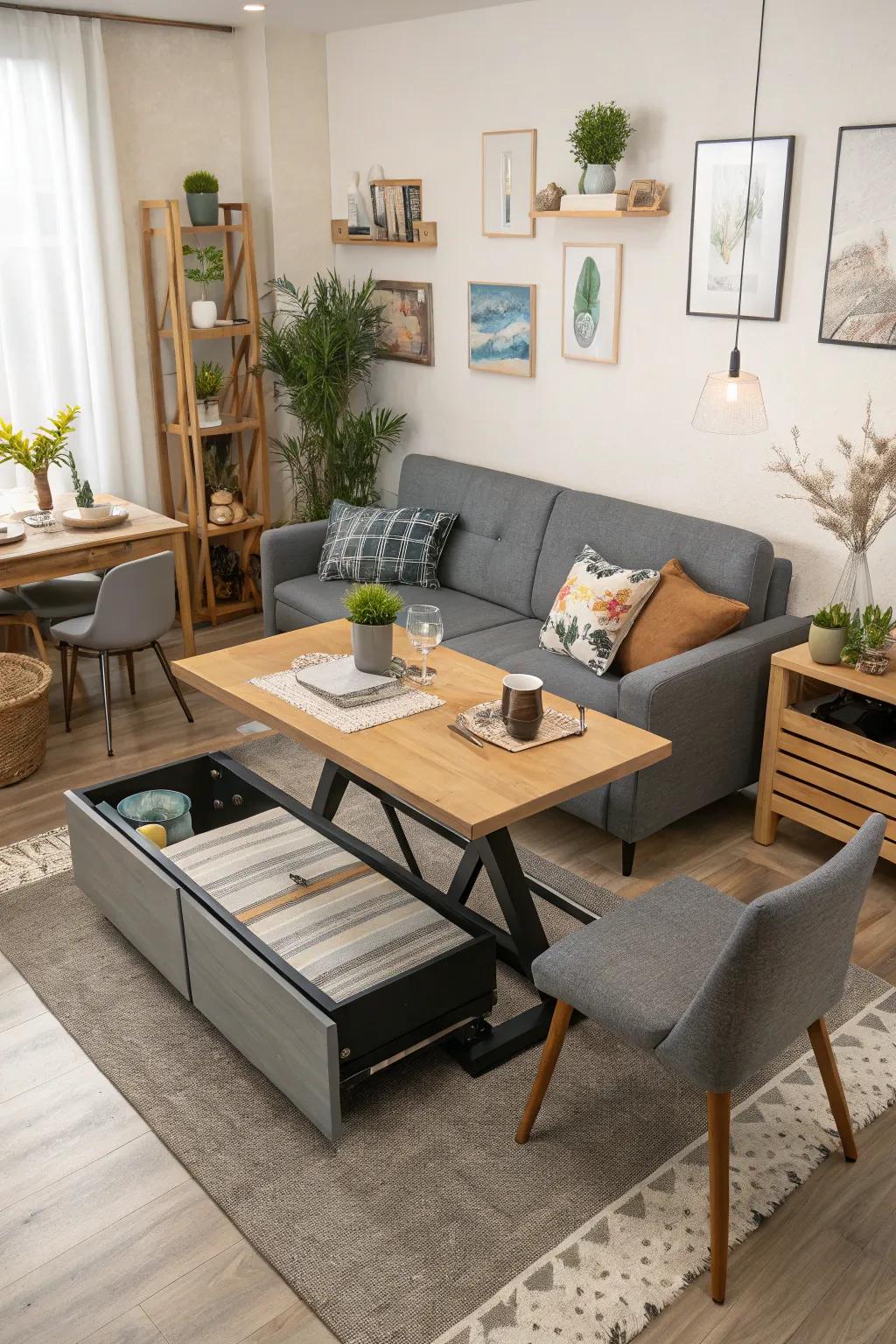
In a compact space, every piece of furniture needs to earn its keep. That’s why I’m always on the lookout for multifunctional marvels—pieces that hide storage or transform for guests without a second thought. Have you ever wished your dining table could shrink or expand to fit the moment? Or that your coffee table could moonlight as a workspace?
Here are three of my go-to multifunctional furniture ideas that clients absolutely love:
- Extendable dining table: For dinners with friends or intimate meals for two.
- Convertible coffee table with lift-top storage: Great for stashing board games, remote controls, or even doubling as a desk.
- Sofa bed: Perfect for overnight guests—with zero compromise on everyday comfort.
I once helped the Martinez family, who host game nights every Friday but needed a quiet reading nook the rest of the week. We chose a stylish extendable table for their dining spot and a plush storage ottoman that hides toys in a flash. Their faces lit up when they realized their home could flex right along with them.
Small rooms might set limits—but your furniture doesn’t have to.
These products might help:
3. Let There Be Light!
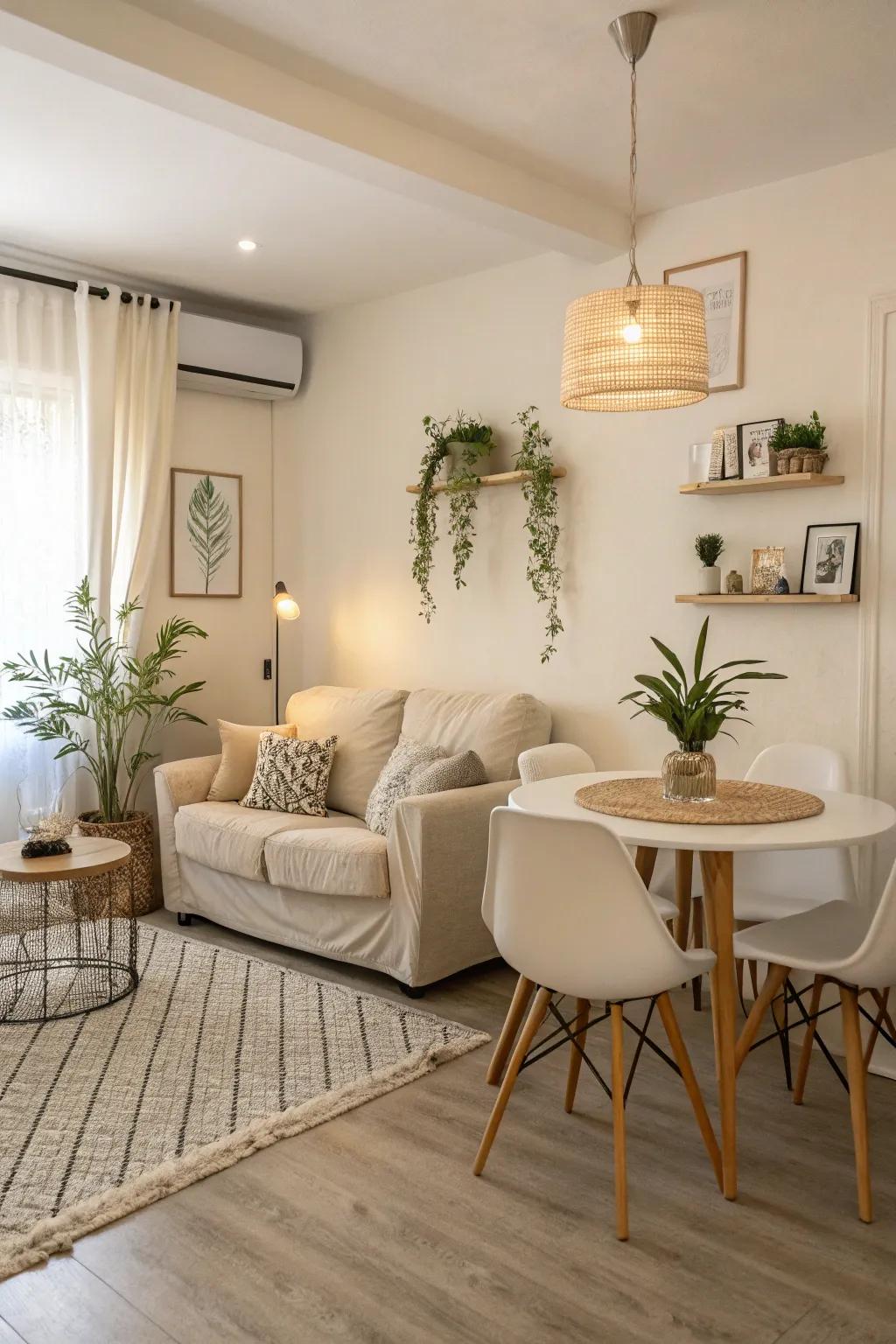
The quickest way to banish that boxed-in feeling? Lean into light and neutral colors. Layer whites, creams, and soft beiges on your walls and furniture—your space will not only reflect natural light, it’ll feel instantly more expansive. If you’re ever unsure, just remember: a pale palette is always your friend in a small room.
It’s like opening the windows to a whole new world.
You might give these a try:
4. Unfolding Possibilities: How Nesting Tables Transform Tiny Spaces
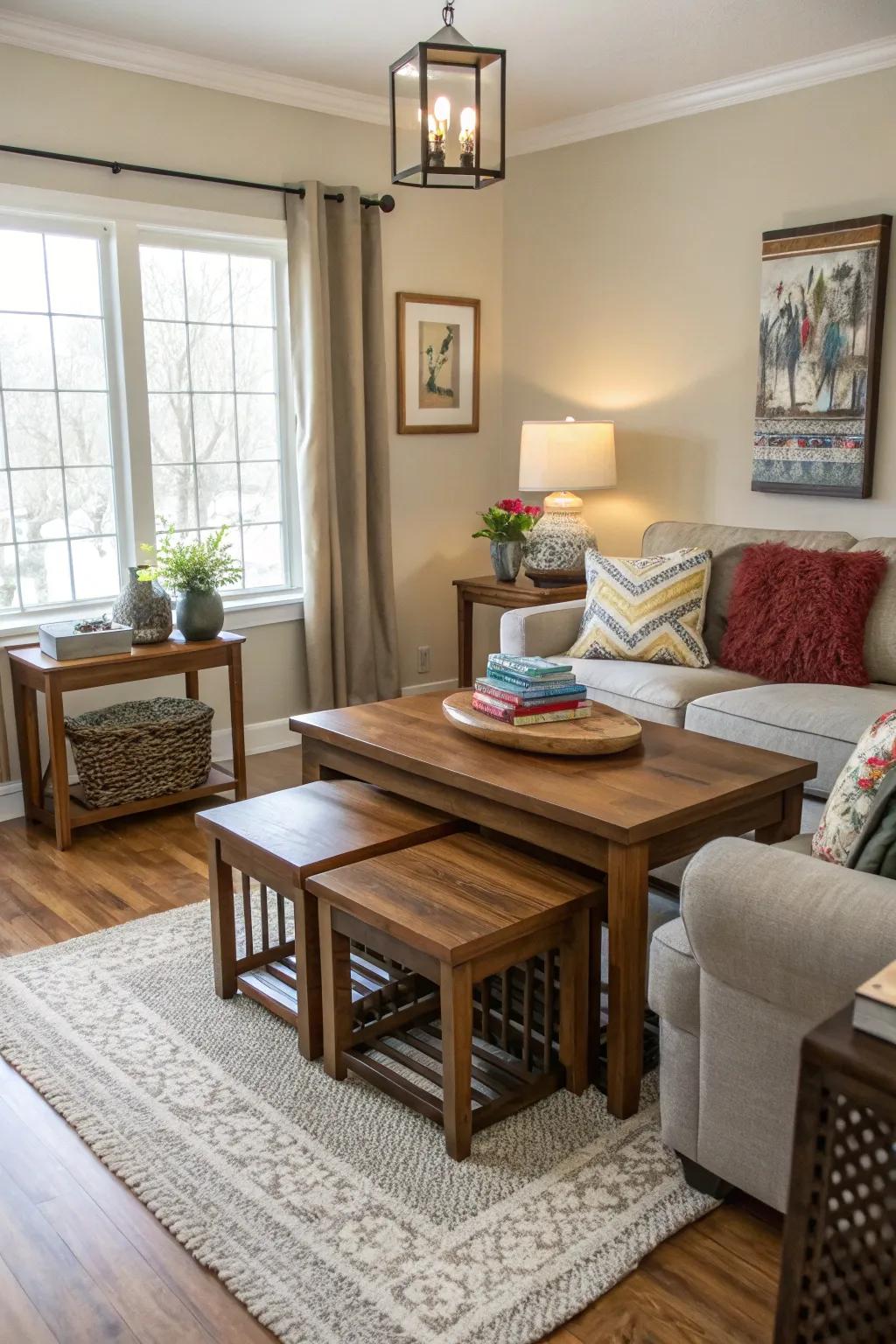
Every inch matters when you’re working with a compact living room and dining room combo. That’s why I always get excited about nesting tables—they’re like little space-saving magicians hiding in plain sight. When you need an extra spot for your coffee, to serve snacks, or even set up a laptop for a quick work session, you can just pull another table out and voilà: instant surface, no elbowing needed.
You don’t have to sacrifice style for flexibility, either.
Let’s think beyond the ordinary. Have you ever noticed how nesting tables can do double (or triple) duty? Try these creative uses the next time you need your space to multitask:
- Stack and stagger them for a tiered display; it’s a sneaky way to show off plants, art books, or even fresh flowers.
- Use the smaller table as a stand-in nightstand or a breakfast tray when guests are staying over.
- Tuck the set aside altogether for an open, breezier feel during gatherings, then bring them back when it’s movie night and popcorn central.
I once worked with Sofia, a young writer who loved to entertain friends even though her apartment was the size of a postage stamp. Nesting tables let her create a buffet line for brunch, then simply slide them away to dance the night away with her guests. It’s all about living large, no matter the footprint.
A few choices to try:
5. How Do You Create Seamless Flow Between Living and Dining?
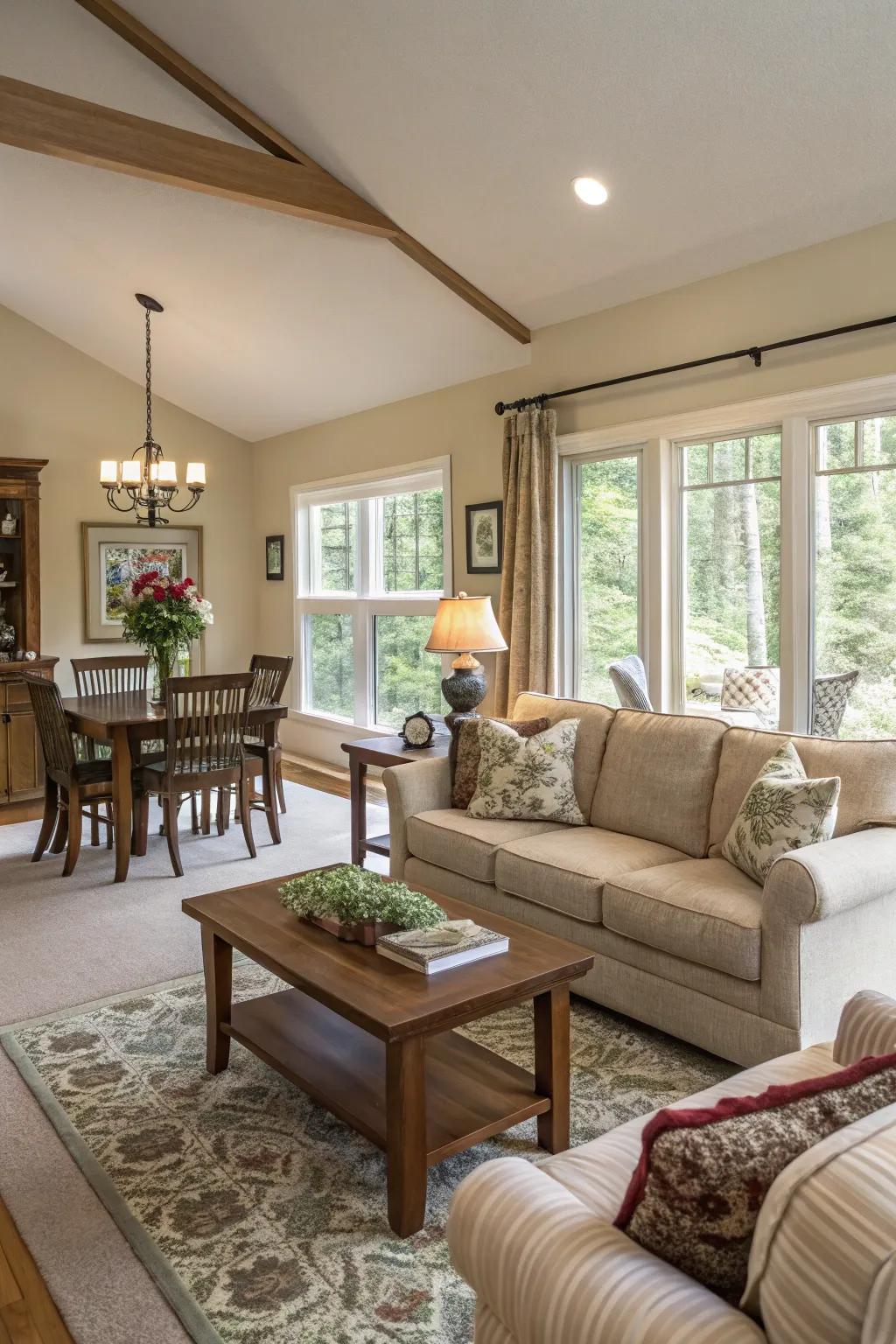
When I walk into a small home with a combined living and dining area, the first thing I notice is whether the space flows—or if it feels like two awkwardly stitched-together rooms. The magic, I’ve found, is all about visual harmony and intentional choices. Rather than forcing hard boundaries, I like to let one room gently lead into the next, almost as if they’re in conversation.
One of the most effective tricks is to choose a consistent color palette and coordinate your furniture styles. This doesn’t mean everything has to match perfectly (where’s the fun in that?), but picking a few unifying details will help even a tiny space feel thoughtfully put together.
Here are four ways I often help clients blend their spaces seamlessly:
- Layer textiles in similar hues for a soft, pulled-together look.
- Use low-profile furniture to keep sightlines open and welcoming.
- Choose art or decor pieces that echo tones found in both rooms.
- Add greenery—plants are the ultimate go-between!
One client’s home stands out in my mind: Chloe and Mark wanted room to entertain, but their small combo area felt disjointed. We used a creamy area rug to anchor both zones, then mirrored wood finishes from their dining chairs in the living room with a matching coffee table. Suddenly, their space felt effortless—like it was always meant to be.
Seamless flow isn’t just about looks—it’s about how you feel moving through your home. Why settle for less than harmony?
Maybe worth checking out:
6. Strategic Use of Plants
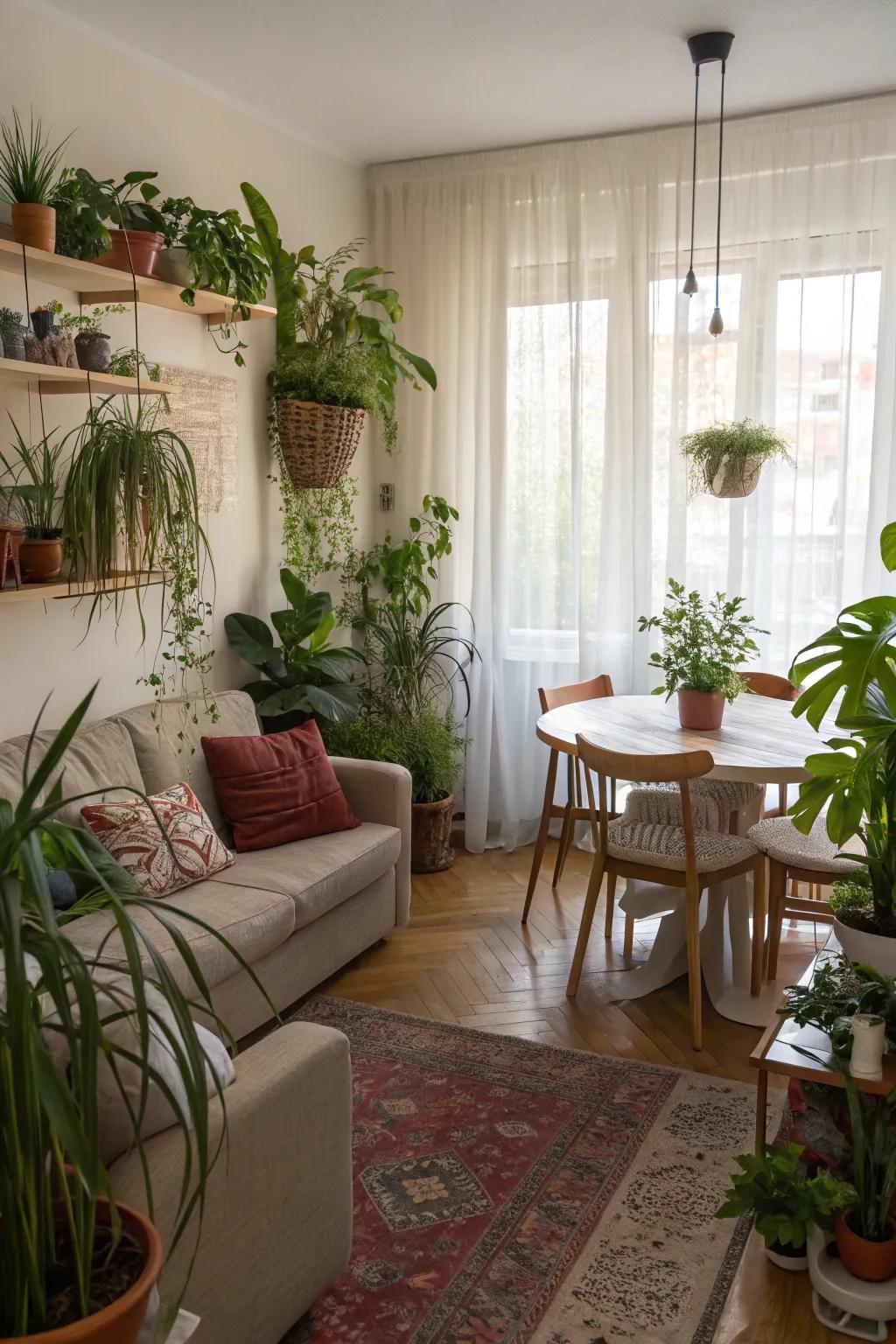
Use plants strategically to bring life and color to your space. They can also define areas and add a touch of nature.
Explore these options:
7. Let It Float!
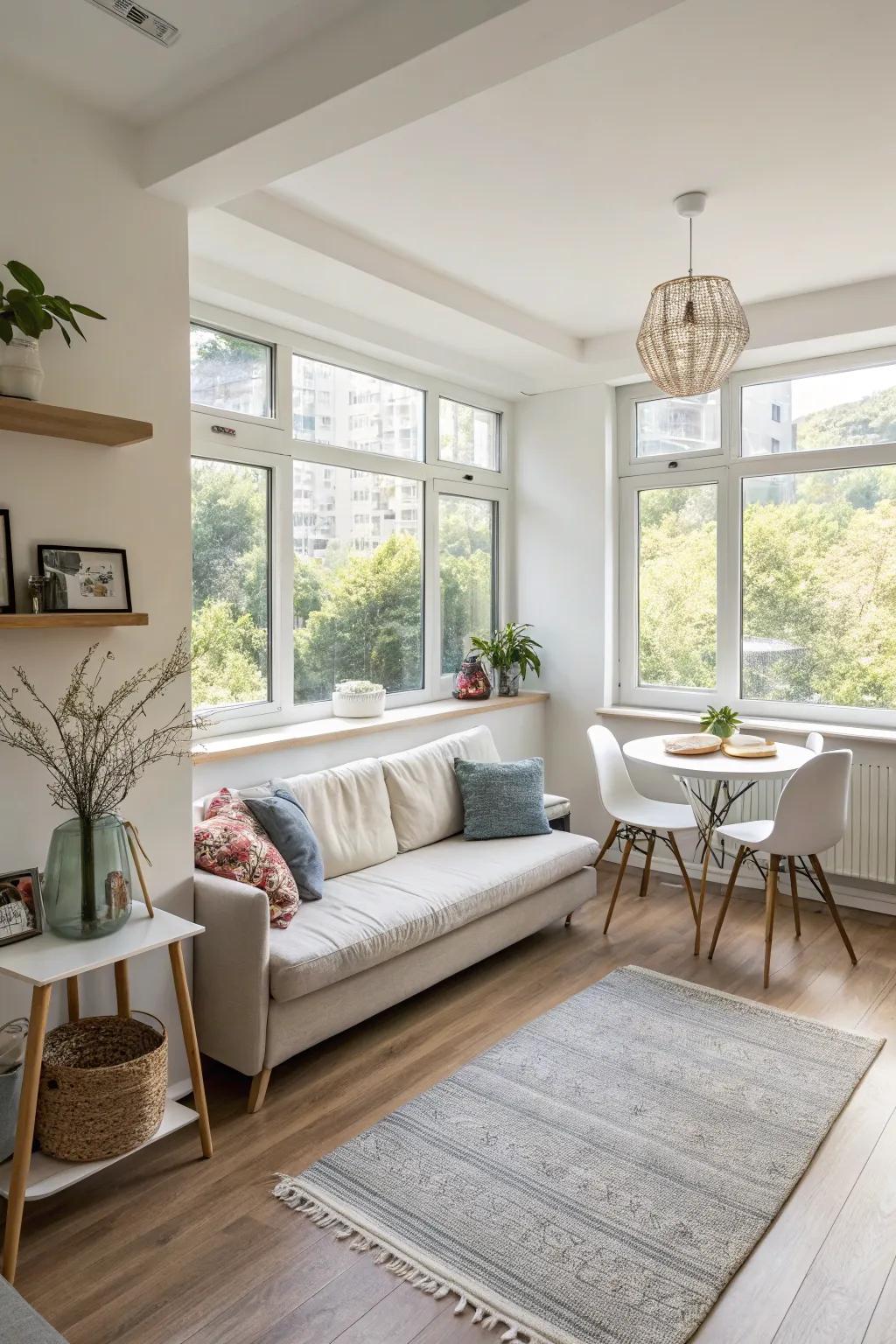
Floating some pieces, like your sofa or shelves, creates airiness—that elusive, breezy quality every small combo room craves. When furniture hugs the walls, things can feel boxy. But let them float just a little?
You’ll be amazed how the energy (and light) flows!
Give your space room to breathe.
A few helpful options:
8. Just Enough
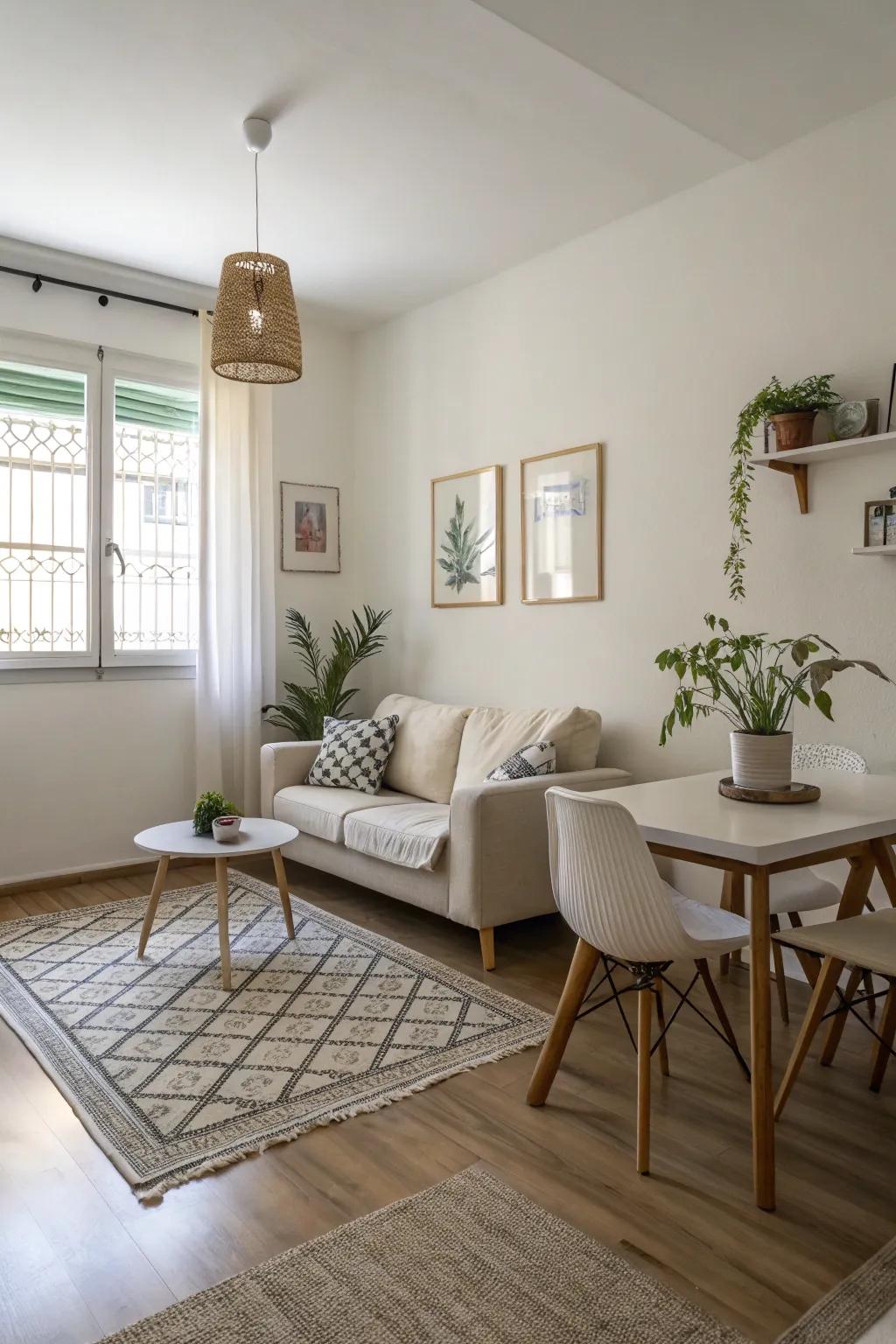
If you’re feeling overwhelmed by a small space, try removing one decorative piece and see if the room breathes easier. Minimalism is your friend here.
The fewer things you have, the more each beloved item stands out.
Give these a look:
9. Cozy Corners, Happy Gatherings—Let’s Rearrange!
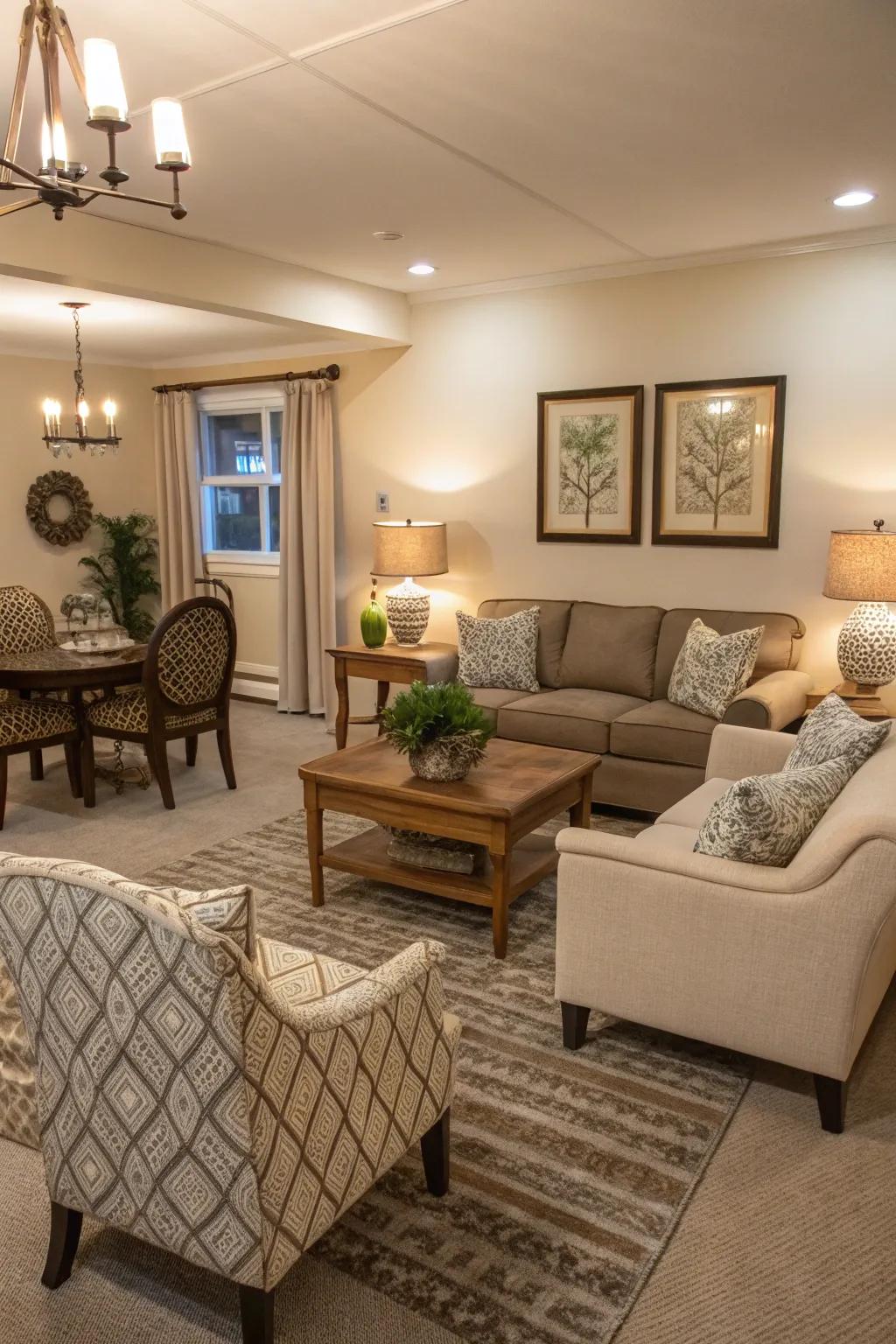
A small combo room doesn’t have to feel cramped—it can feel incredibly inviting with the right seating setup. The arrangement of your seats sets the tone for connection, comfort, and—even in the tiniest spaces—fun.
Nothing brings people together like a thoughtfully placed chair or sofa.
Try anchoring your layout with a compact sofa or loveseat, then soften the lines with an accent chair or two. Facing pieces inward (rather than everything pressed against the walls) makes the space feel more intimate. Consider these two quick ideas:
- Float the couch slightly away from the wall to open up walkways and conversation zones.
- Place an accent chair near the dining table so both areas feel visually and socially connected.
Want an even cozier touch? Here are some of my favorite small-space tricks:
- Layer in a plush, textured rug to anchor your arrangement.
- Add a couple of soft throw pillows or a chunky knit blanket.
- Use a small round coffee table to keep traffic flowing (and snacks handy!).
When I helped the Thompsons shape their first multipurpose room, they worried about feeling boxed in. We worked together to create a “conversation zone” with a convertible loveseat, cozy rug, and a pair of slim armchairs angled toward the window. Their weekly game nights turned legendary! The best part? Every seat felt like the best seat.
Why not bring a little of that togetherness to your own combo space? Imagine friends sharing stories over dessert or a loved one curling up with a book—it all starts with a seat that welcomes you in. After all, a cozy corner can make even the smallest room feel grand.
Useful items to consider:
10. Divide and Conquer (Without Closing Off Your World): Sliding Door Magic
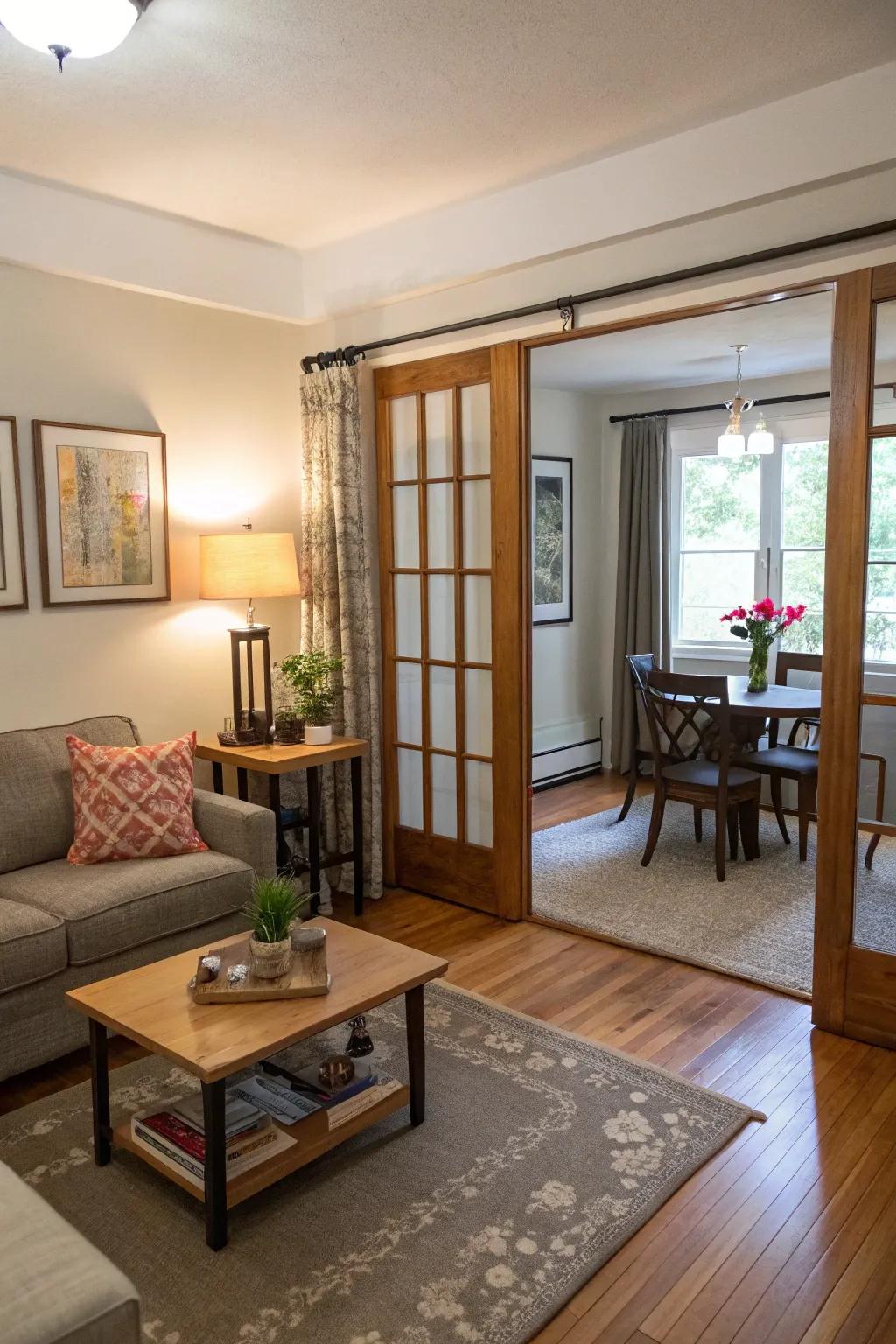
Sometimes, a small space needs the power to flex with your day—feeling open when you need to spread out, yet offering privacy when you crave a little quiet.
Last year, I helped Sarah, a busy mother of three, reimagine her open-plan living/dining area. She wanted her children nearby for family meals but absolutely needed to create a calm pocket for her work-from-home days. We chose a frosted glass sliding door: stylish, space-saving, and easy for little hands to use. What a transformation! Now, Sarah can close off her workspace when the calls begin, or slide open the door so Sunday sunlight floods the whole room.
Sliding doors can:
- Create a fluid division between living and dining areas—close for focus, open for connection.
- Enhance flexibility, allowing you to redefine the space for dinner parties or quiet movie nights.
- Bring architectural style without blocking light or crowding the room.
It’s remarkable what a single sliding door can do—sometimes the smallest gestures bring the grandest sense of possibility.
Let your space breathe and adapt with you.
May just do the trick:
11. Practical Decor Ideas
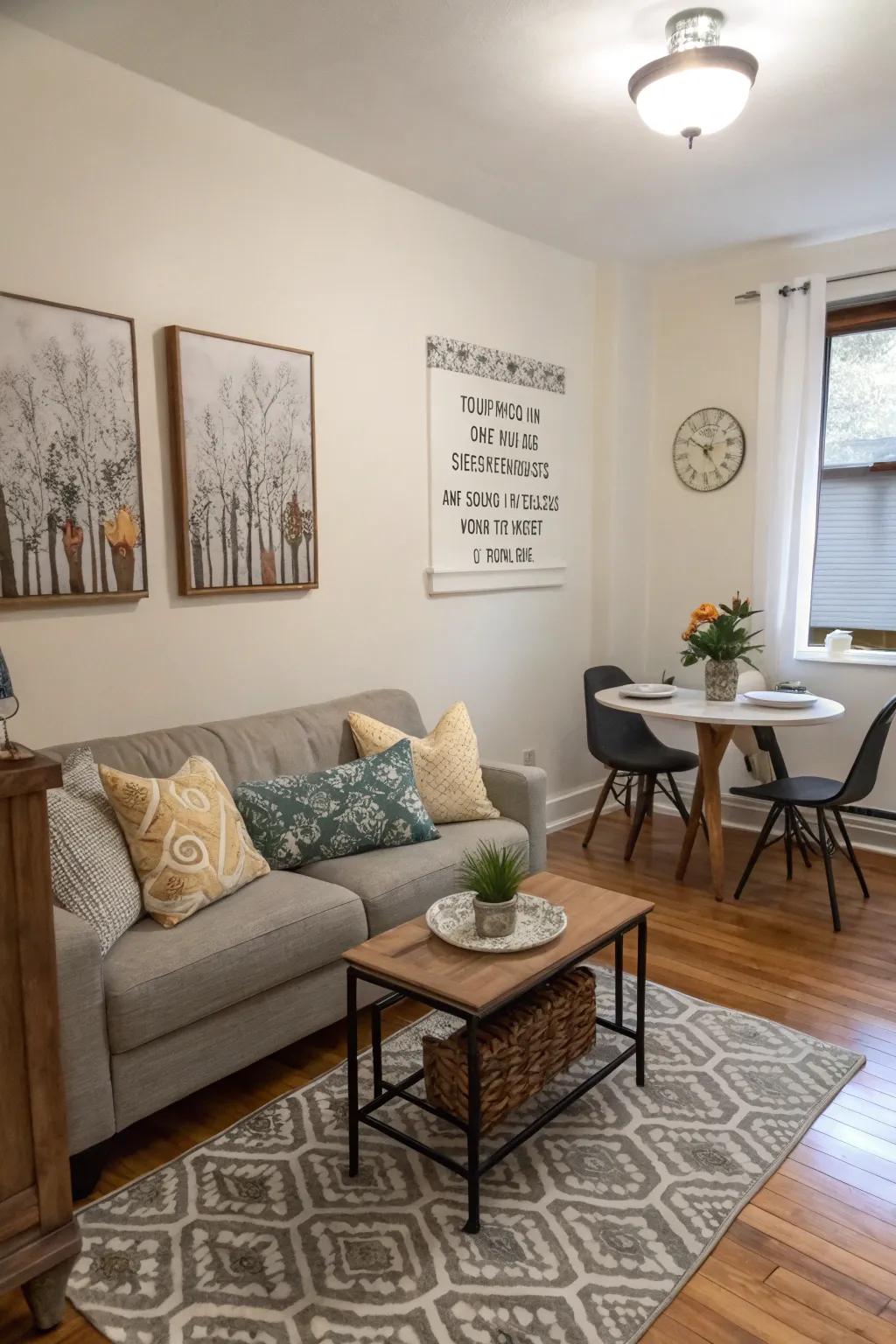
Choose decor that adds personality but doesn’t take up too much space. A statement piece can go a long way.
You might like:
12. Let There Be Layers: Illuminating Your Space with Ambiance
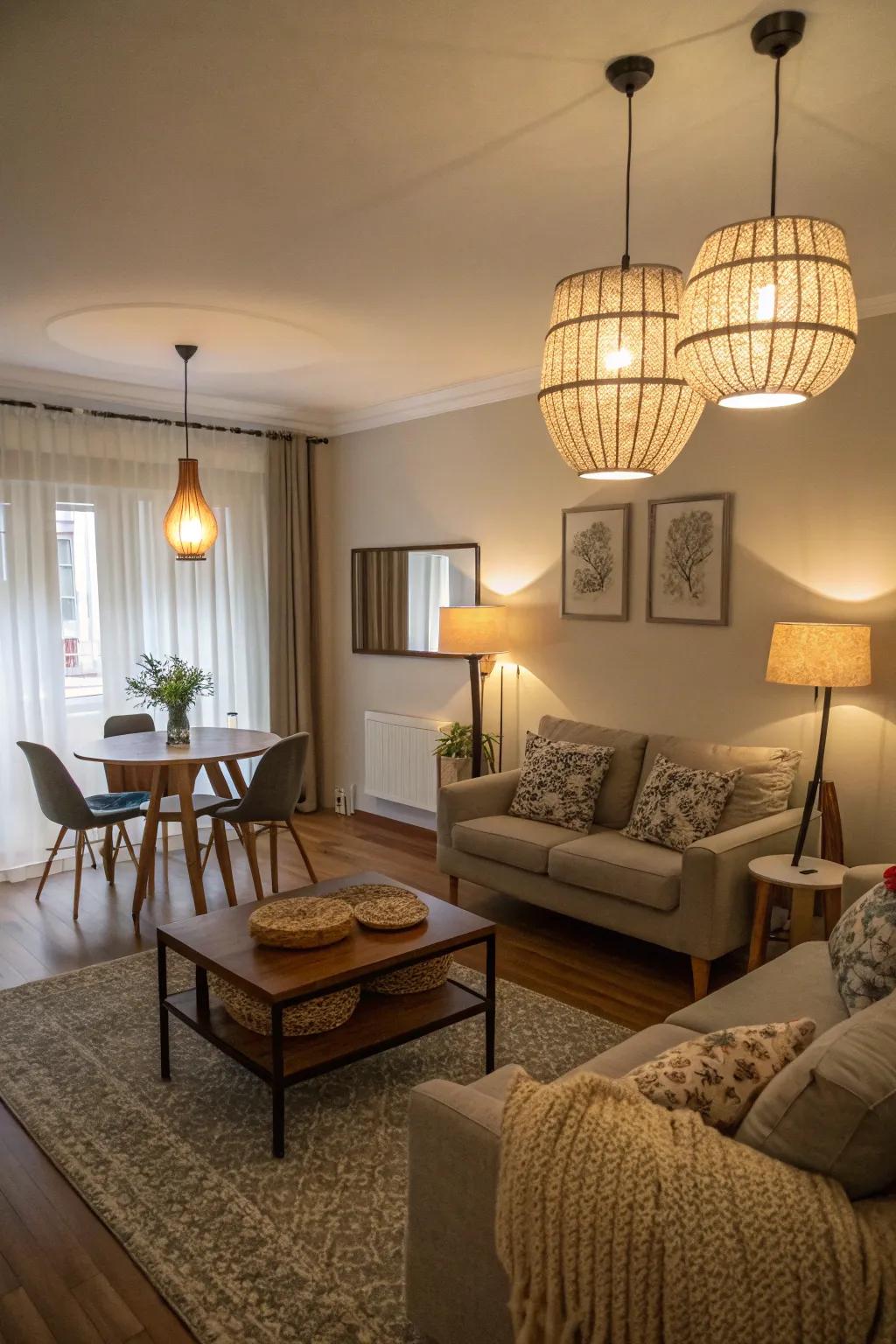
There’s something truly transformative about how light plays in a room—especially when space is at a premium and every corner counts. The right lighting doesn’t just illuminate; it shapes mood, function, and even the size of your small living room dining room combo.
For a dynamic, cozy space, I always recommend layering your lighting much like you’d layer your favorite cozy throws: each layer adds depth and a new function. Start with ambient lighting to blanket the space in a soft, inviting glow. Next, use focused task lighting (like a pendant above the dining table or a reading lamp by your favorite chair) to give each zone its own purpose. Decorative accent lights highlight unique features and add a playful sparkle.
Here are three essential lighting layers I almost always use in my clients’ combos:
- Ambient ceiling fixtures: These set the tone for the whole space.
- Task lamps: Place these where you read, dine, or work for focused light.
- Dimmer switches: These let you fine-tune brightness and set the mood.
Lighting with dimmers is a secret ingredient for instant ambiance. You can go from bright and productive to warm and intimate in just a twist. I remember working with Linda and James, who wanted their open-plan space to function both as a bustling hub for dinner parties and a peaceful haven for unwinding. By layering pendants over their table, a soft floor lamp by the sofa, and adding dimmer switches to both, we struck the perfect balance. Their friends now constantly comment on how the atmosphere adapts to every occasion!
A thoughtfully lit space feels like home—no matter the square footage.
A few suggestions:
13. Unlocking Height: Transformative Ways to Use Vertical Space in Small Combos
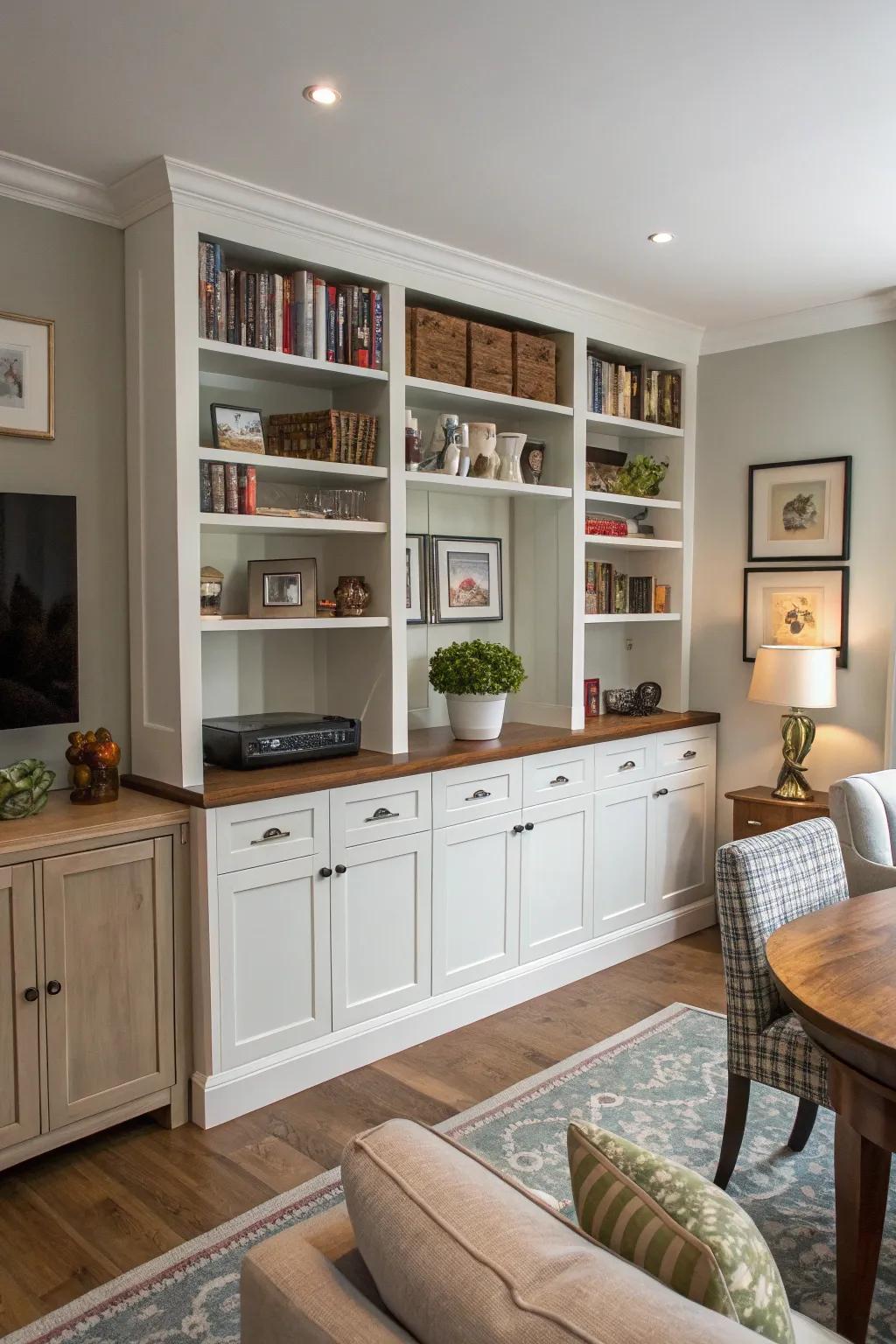
If you’ve ever walked into a small living-dining combo and wondered, “How do I make this feel more open without losing function?”—you’re not alone.
One of my favorite tricks as a designer is to encourage the eye to wander upwards. When you embrace vertical storage—think tall, slender bookshelves, wall-mounted shelves, or cabinets that soar toward the ceiling—you instantly add storage without swallowing up floor area. Here’s how to put this into action:
- Install shelves above existing furniture, like sofas or sideboards, to create display space for books, art, or treasured curios.
- Opt for cabinets that reach as high as your ceilings allow, minimizing floor clutter and making room for foot traffic.
- Hang a staggered set of wall-mounted shelves at varying heights for an artistic, layered effect.
I once worked with a wonderful couple, Holly and Marc, who felt boxed in by their small lounge-dining space. We chose a sleek, floor-to-ceiling bookcase for their shared wall and floated a trio of simple shelves above their compact dining nook. Not only did it solve their storage dilemma, but the room felt instantly taller, lighter, and much more inviting. Holly said, *”It finally feels like we’re living large—even in a small space!”
Remember: Vertical space is your untapped resource. Choose finishes and colors that complement your walls for cohesive flow. Don’t be afraid to mix open and closed storage, and always double-check anchor points when installing heavier pieces. Just a few smart upgrades can open up your room in beautiful, unexpected ways.
Items that may come in handy:
14. How Can Clever Storage Shape Your Combo Room?
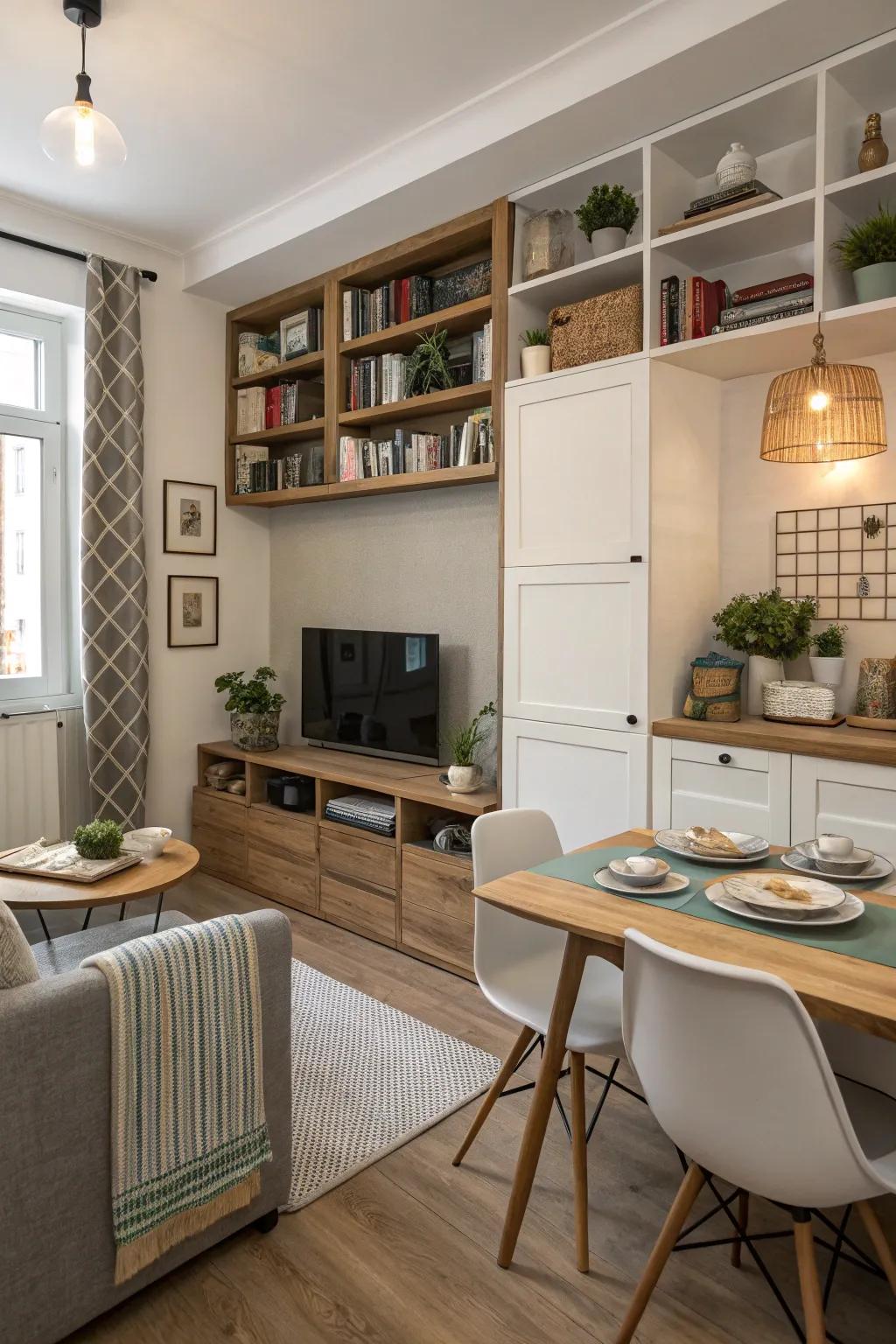
In tight spaces, storage isn’t just about hiding things—it’s about maximizing every vertical inch and creating visual calm. The trick? Think in layers, ledges, and clever concealment.
- Go vertical with floating wall shelves for books or plants.
- Choose furniture with hidden storage compartments.
- Use baskets under the coffee table to corral daily clutter.
- Opt for expandable tables that tuck away when not in use.
Everything has its place—and sometimes, that place is out of sight.
I once worked with Sarah, a busy mother of three, who was desperate to reclaim her living room. We integrated bookshelves that doubled as room dividers, ottomans with deep storage, and a slim dining table that expanded for guests. Her relief was palpable: a tidy room, a clear mind!
A few things you might like:
15. Draw the Line (Without Building a Wall)
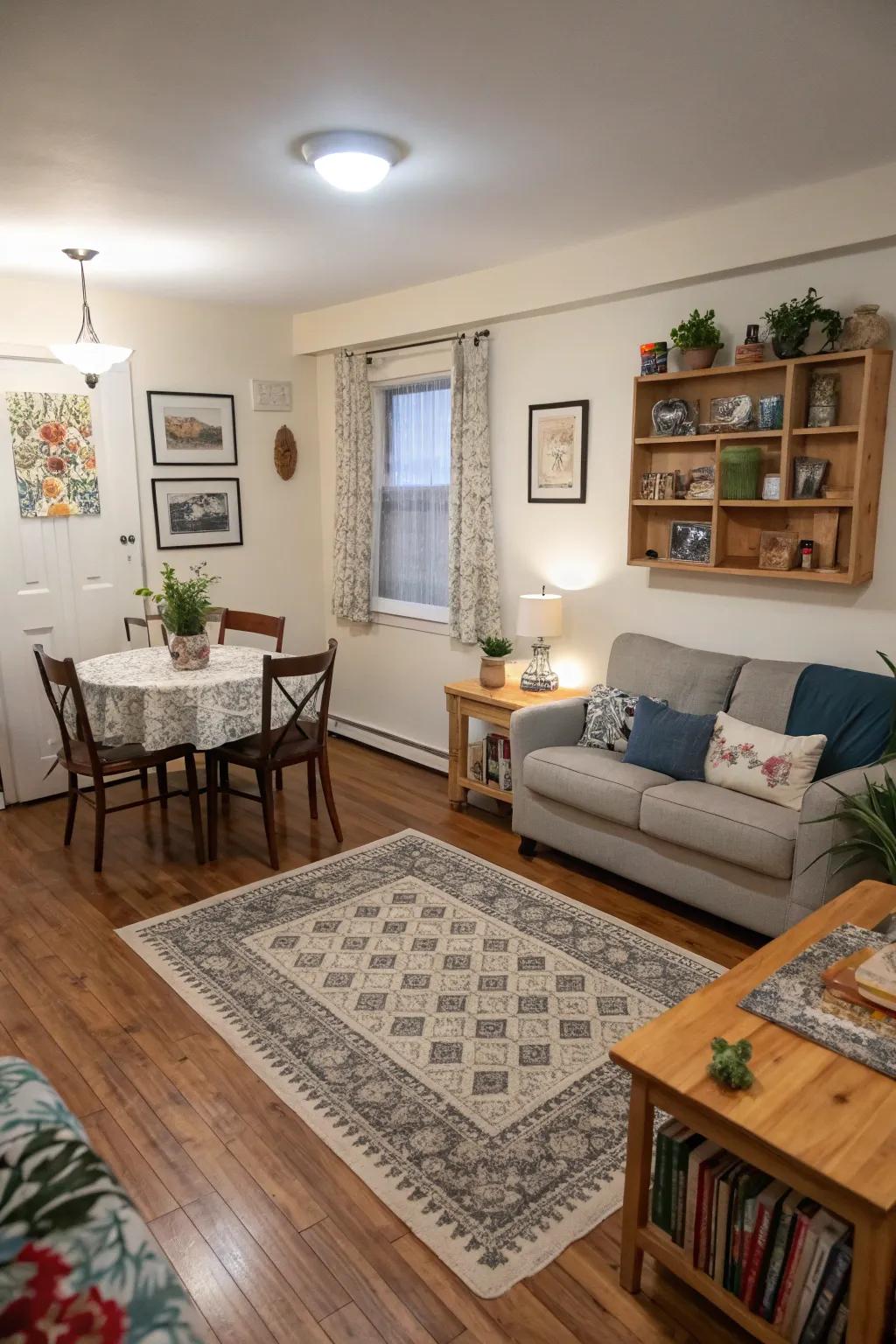
Rugs are your secret superpower.
Want to subtly mark where your living area ends and the dining space begins? Throw down a rug and watch your room transform—no construction required. A thoughtfully chosen rug, whether bold or understated, acts as a visual anchor and gives each zone a sense of purpose without losing any of that precious openness.
- Choose different patterns or textures for each rug to define zones, but echo color themes for harmony.
- Make sure the rug fits—large enough to ground furniture, small enough not to overwhelm.
Try switching things up seasonally or layering two smaller rugs for unexpected dimension. Sometimes, the simplest trick delivers the biggest wow.
Products that could assist:
16. Hello, Personality! Accent Walls Make a Statement
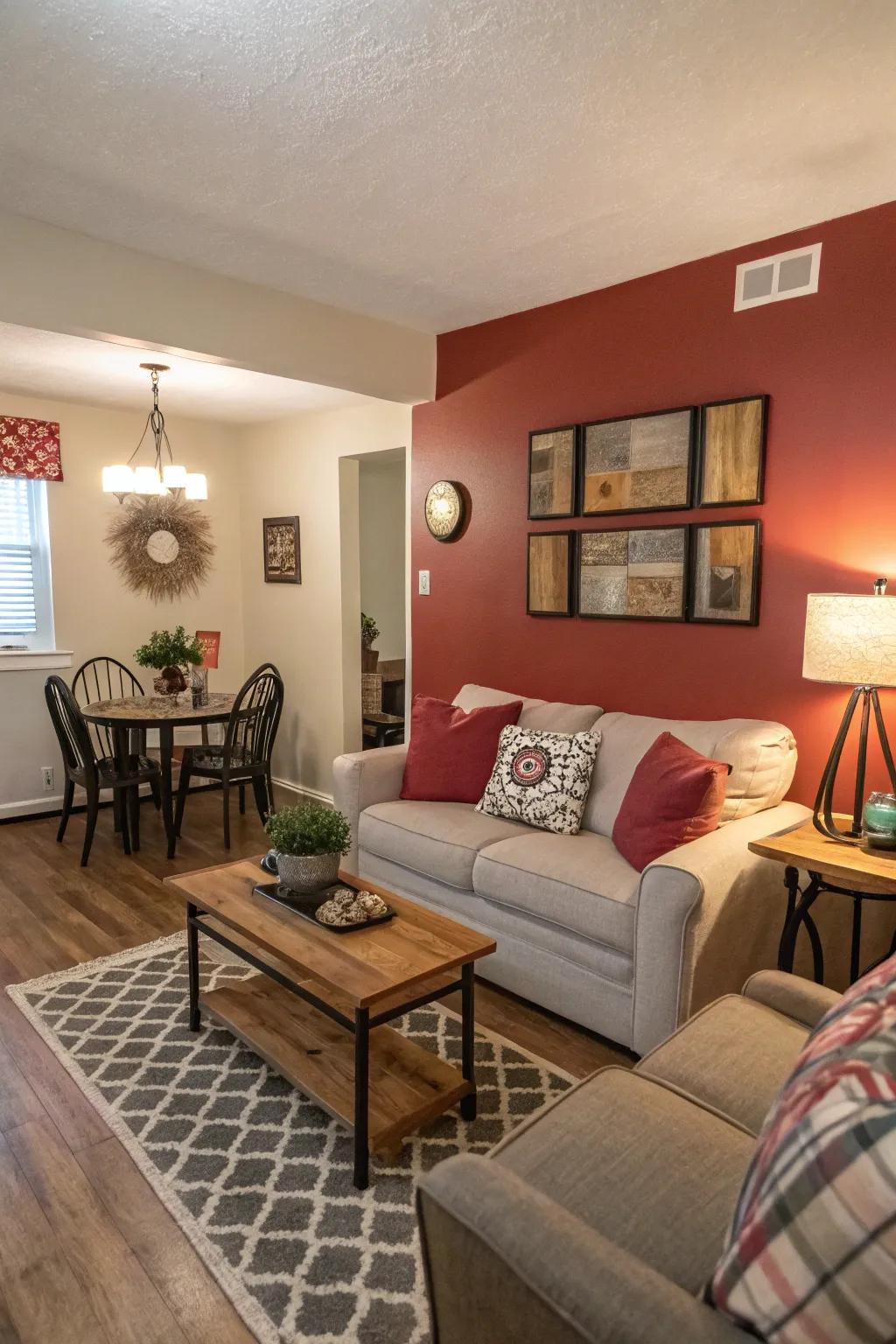
There’s an art to making a small living-dining combo feel welcoming and full of character—without overwhelming it. That’s where accent walls shine! A well-chosen color, removable wallpaper, or curated art cluster instantly adds depth, dimension, and a little bit of drama.
I’ll never forget working with Mia, who wanted her open-plan space to feel “more like us, less like a blank page.” We chose a lush forest green paint behind her dining set and it changed everything. Suddenly, her cherished art prints and heirloom plates looked intentional, not crowded. It’s amazing how a single wall can set the mood for the entire room!
Ready to create your own accent wall? Here’s how to get started:
- Pick a wall that draws the eye naturally—behind your table, sofa, or even beside a window.
- Choose your finish: bold paint, subtle texture, or a playful removable wallpaper.
- Layer in art, mirrors, or shelves for interest and utility.
- Keep the rest of your palette simple, so your accent wall can truly sing.
Your accent wall can be as bold or as gentle as you like. It’s all about expressing yourself in the space you call home.
These products might be useful:
17. A Tapestry of Touch: Play with Textures for Inviting Depth
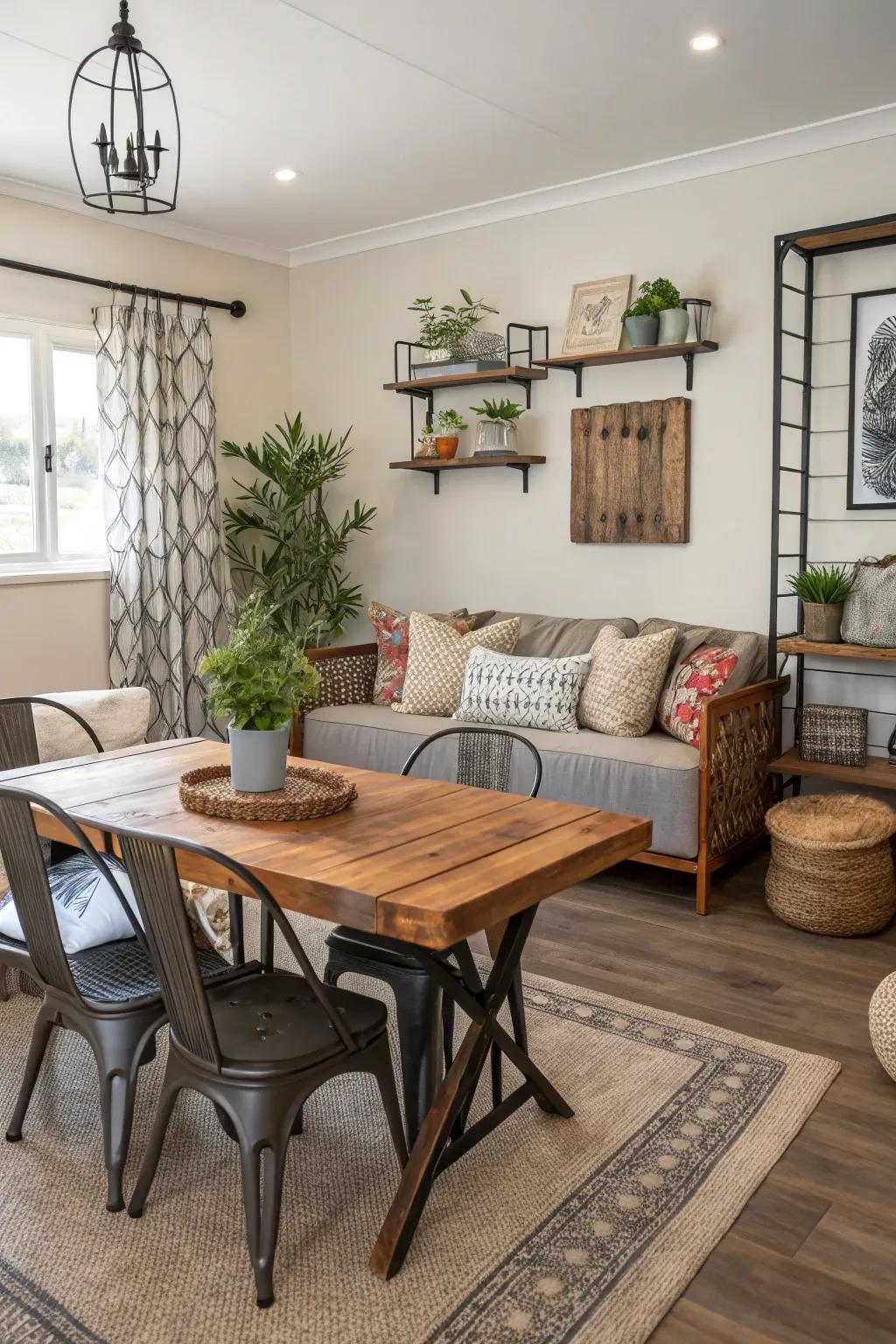
If you want your small living room and dining combo to truly sing, try layering it with the magic of texture. It’s not just about what you see—it’s about what you feel, and the subtle richness that comes from mixing materials.
I’ve noticed time and time again that when you weave together wood, metal, woven textiles, and plush fabrics, something almost alchemical happens to the space.
Take my experience with the Thompsons, a delightfully eclectic couple who were nervous that their open-plan combo would feel flat. We started by anchoring their space with a raw-edged wooden coffee table, then brought in industrial metal dining chairs to punctuate the look with a contemporary note. The real transformation came when we scattered textured throw pillows—velvets, chunky knits, even a nubby linen—in both zones. Suddenly, their once-bland room felt like a conversation starter.
The best combinations often include:
- Hearty wood (like a reclaimed table or rustic shelf)
- Cool metal (such as chair legs or lighting fixtures)
- Tactile accents (think woven throws or embroidered cushions)
Each of these adds a distinct layer. The trick? Don’t overthink it. Mix, match, and let your hands wander as much as your eyes.
Let your space invite touch—because a textured room never feels sterile. Can you imagine sinking into those pillows after a long day?
Check these products out:
18. Double Duty!
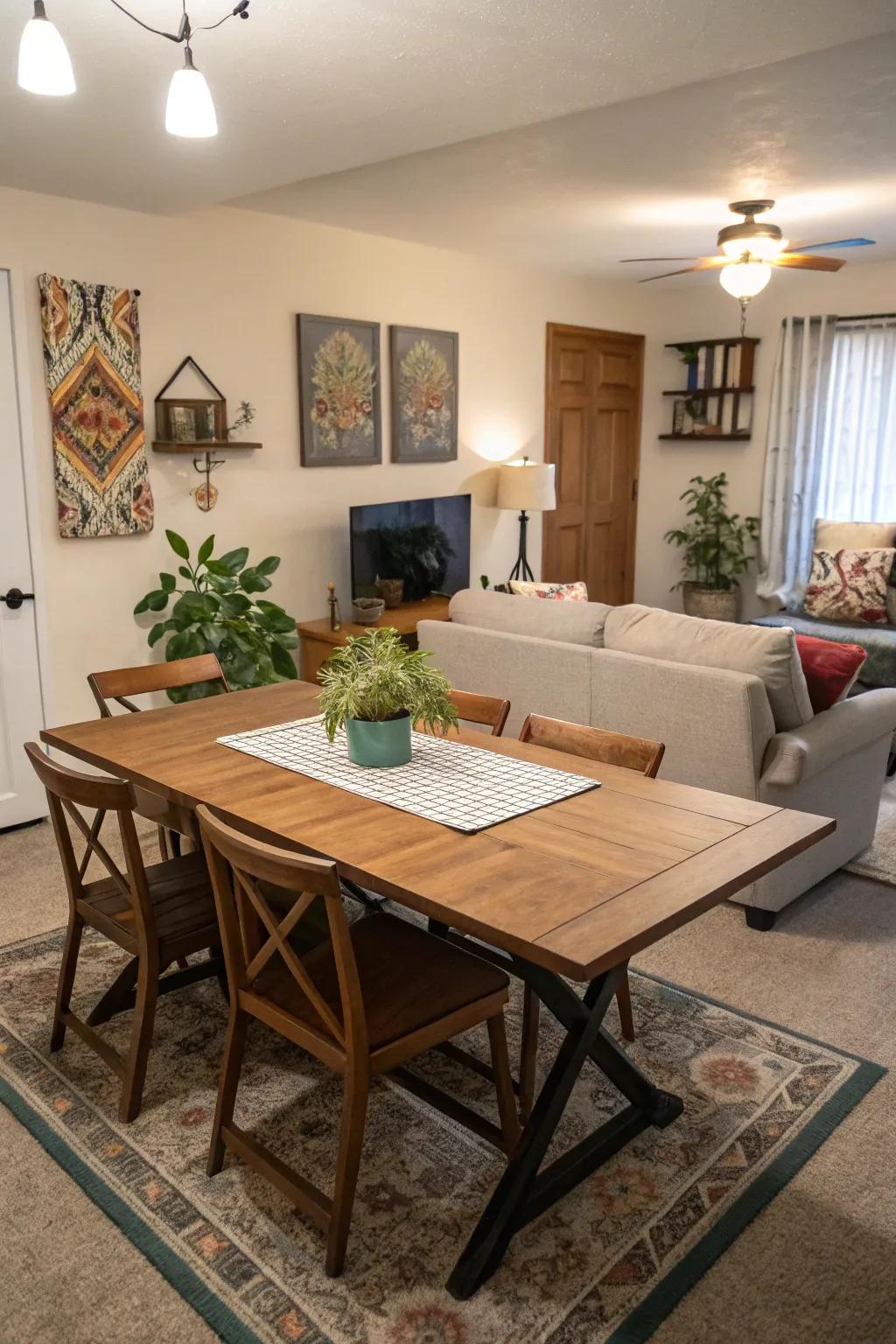
Nothing beats the clever magic of an extendable table in a small living-dining room. It stays compact for everyday meals or work-from-home mornings, but stretches out effortlessly when friends stop by. If you crave versatility without the clutter, this single piece can change the way you use your entire space. Smart, right?

